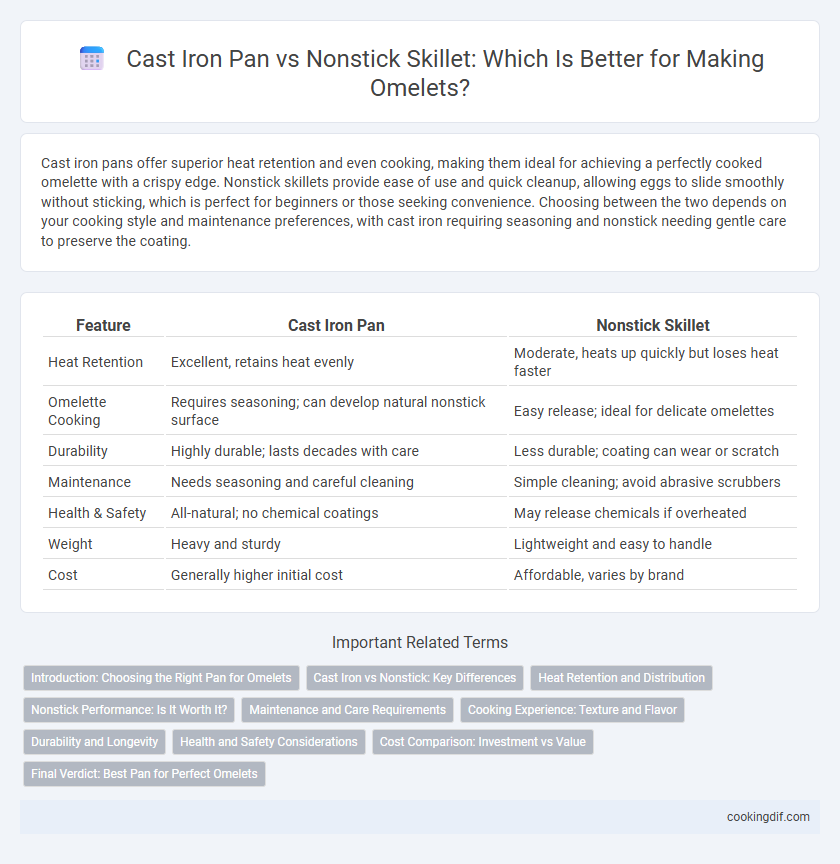Cast iron pans offer superior heat retention and even cooking, making them ideal for achieving a perfectly cooked omelette with a crispy edge. Nonstick skillets provide ease of use and quick cleanup, allowing eggs to slide smoothly without sticking, which is perfect for beginners or those seeking convenience. Choosing between the two depends on your cooking style and maintenance preferences, with cast iron requiring seasoning and nonstick needing gentle care to preserve the coating.
Table of Comparison
| Feature | Cast Iron Pan | Nonstick Skillet |
|---|---|---|
| Heat Retention | Excellent, retains heat evenly | Moderate, heats up quickly but loses heat faster |
| Omelette Cooking | Requires seasoning; can develop natural nonstick surface | Easy release; ideal for delicate omelettes |
| Durability | Highly durable; lasts decades with care | Less durable; coating can wear or scratch |
| Maintenance | Needs seasoning and careful cleaning | Simple cleaning; avoid abrasive scrubbers |
| Health & Safety | All-natural; no chemical coatings | May release chemicals if overheated |
| Weight | Heavy and sturdy | Lightweight and easy to handle |
| Cost | Generally higher initial cost | Affordable, varies by brand |
Introduction: Choosing the Right Pan for Omelets
Selecting the ideal pan for omelets significantly impacts texture and cooking ease, with cast iron pans offering superior heat retention and even cooking, enhancing flavor development. Nonstick skillets provide effortless egg release and quick cleanup, ideal for delicate omelet folds and daily use. Understanding pan material and heat distribution optimizes omelet quality and cooking experience.
Cast Iron vs Nonstick: Key Differences
Cast iron pans provide superior heat retention and even cooking, making them ideal for achieving a perfectly browned, crispy omelette edge. Nonstick skillets offer effortless release and easy cleanup, reducing the risk of omelette sticking and tearing. While cast iron requires seasoning and maintenance to prevent rust, nonstick pans typically have a limited lifespan due to coating wear but excel in quick, delicate cooking tasks.
Heat Retention and Distribution
Cast iron pans excel in heat retention and even distribution, ensuring consistent cooking temperatures ideal for perfectly cooked omelettes. Nonstick skillets heat up quickly but may have uneven heat spread, which can cause hot spots and uneven cooking. The superior thermal properties of cast iron make it a preferred choice for chefs seeking precise control over omelette texture and browning.
Nonstick Performance: Is It Worth It?
Nonstick skillets offer superior nonstick performance that simplifies cooking and cleanup, making them ideal for preparing delicate omelettes without tearing. Cast iron pans require proper seasoning and maintenance to develop a natural nonstick surface but provide excellent heat retention and even cooking. Choosing between them depends on prioritizing ease of use and convenience versus durability and heat control.
Maintenance and Care Requirements
Cast iron pans require seasoning and careful drying to prevent rust, making their maintenance more involved compared to nonstick skillets, which need gentle cleaning and avoidance of metal utensils to preserve their coating. Cast iron offers durability and improved nonstick performance over time with proper care, while nonstick pans typically have a shorter lifespan due to coating wear. Choosing between these depends on the user's willingness to perform regular upkeep for longevity or prefer easier maintenance with potential replacement.
Cooking Experience: Texture and Flavor
Cast iron pans provide superior heat retention and even cooking, resulting in an omelette with a crispy, golden crust and enhanced depth of flavor through natural seasoning. Nonstick skillets offer a smooth, delicate texture ideal for tender omelettes, minimizing oil use and preventing sticking but may lack the robust flavor development found in cast iron. Choosing cast iron emphasizes a richer, more complex taste and firmer texture, while nonstick prioritizes ease and a soft, uniform finish.
Durability and Longevity
Cast iron pans offer exceptional durability and can last for generations with proper care, developing a natural nonstick surface over time. Nonstick skillets provide easy release and cleaning but tend to wear out faster due to coating degradation, typically lasting 3 to 5 years. For omelette preparation, cast iron's longevity and heat retention make it a preferred choice for consistent, even cooking.
Health and Safety Considerations
Cast iron pans offer superior heat retention and naturally non-stick surfaces with proper seasoning, minimizing the need for chemical coatings that could degrade and pose health risks. Nonstick skillets often contain PTFE coatings like Teflon, which may release toxic fumes if overheated above 500degF, raising safety concerns during high-heat cooking. Choosing cast iron reduces exposure to synthetic chemicals and supports safe cooking temperatures, promoting both food safety and long-term health benefits.
Cost Comparison: Investment vs Value
Cast iron pans often require a higher initial investment, ranging from $30 to $70, but offer unparalleled durability and improved seasoning over time, enhancing omelette flavor and texture. Nonstick skillets are typically more affordable, priced between $15 and $40, providing easy cleanup and consistent nonstick surfaces ideal for delicate eggs. Considering long-term value, cast iron pans deliver better return through longevity and versatility, while nonstick skillets suit budget-conscious cooks seeking convenience.
Final Verdict: Best Pan for Perfect Omelets
Cast iron pans provide superior heat retention and even cooking, creating a golden, crispy exterior on omelets while allowing for excellent browning. Nonstick skillets offer effortless release and quick cleanup, minimizing the risk of breaking delicate omelet folds. For the perfect omelet, a high-quality nonstick skillet generally delivers the best balance of ease, texture, and presentation.
Cast Iron Pan vs Nonstick Skillet for equipment Infographic

 cookingdif.com
cookingdif.com